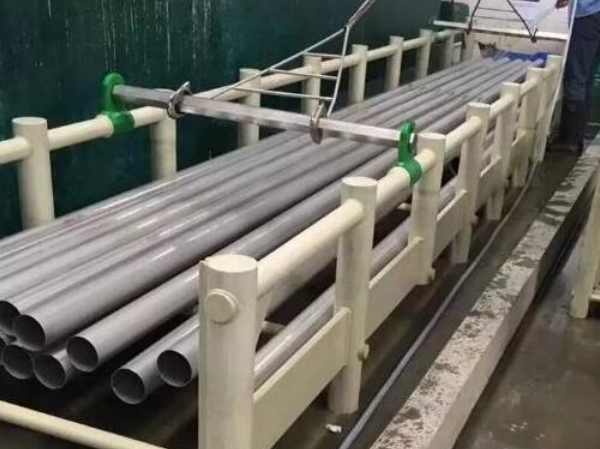During the processing of
stainless steel pipes, black and yellow oxide scales will appear on the surface. In order to improve its corrosion resistance, it must be pickled and passivated after processing. Below, PMC stainless steel belt everyone understands the
304 stainless steel pipe processing technology -- the process of pickling passivation.
1. Chemical degreasing
Stainless steel pipes are generally immersed in a tank for chemical degreasing. The degreasing tank needs to be made of steel plate, and either polyethylene or PVC can be used for it. Then use 12%~15% nitric acid, the temperature is controlled between 40℃~60℃, and the time is 2~4 hours. It should be noted here that when the precision stainless steel pipe is immersed in the tank, the placement position is very important to avoid leaving air in the pipe. During the soaking process, turn the tube 360° to keep the solution in the tube replaced to improve the effect. Until the surface of the precision tube is completely wetted, the purpose of chemical degreasing can be achieved.

2. Rinse with hot water
The
pipe fittings after chemical degreasing are taken out of the degreasing tank, and then immersed in a hot water tank at about 40℃~60℃ for rinsing for 5-20 minutes.
3. Rinse with water
Take out the stainless steel pipe rinsed with hot water, and then rinse it with pressure water (pressure P≥0.1Mpa).
4. Passivation
Adopting the tank bubble method in the tank, the passivation tank steel plate is made, and the inner wall is covered with acid-proof plastic. The temperature of the passivation tank is controlled at 20~25℃, soaked in a 10%~20% volume concentration nitric acid solution for 1 hour. In addition, methods such as dipping, coating, spraying, etc. can be used according to the shape of the tube. For passivation solution, HNO3 should be controlled between 20%-50%. According to electrochemical tests, the quality of passivation film treated with HNO3 concentration less than 20% is unstable and easy to produce pitting corrosion, but HNO3 concentration should not be greater than 50%. To prevent excessive passivation. Finally, the surface of the passivated precision stainless steel tube should be a uniform silver-white protective film.
5. Dry
Passivated precision tubes must be dried with clean compressed air or nitrogen, and there must be enough time (at least 2 hours) to passivate them naturally in the air.
6. Inspection
After the precision stainless steel pipe is passivated, it should undergo self-inspection and mutual inspection, and then submit it to the quality inspector for acceptance as required. Since chemical inspection will destroy the passivation film of the product, it is usually inspected on a sample board. Examples of methods are as follows:
(1) Copper sulfate titration test: Drop 8g CuS04+500mL H20+2~3mLH2SO4 solution onto the surface of the sample plate and keep it in a wet state. If no copper precipitation occurs within 6 minutes, it is qualified;
(2) Potassium ferricyanide titration test: drop 2mL HCl+1mL H2SO4+1g K3Fe(CN)6+97mL H20 solution on the surface of the sample plate, and the quality of the passivation film can be identified by the number of blue spots and the length of time they appear.
7. Packaging
If the outer surface of the pipe still needs to be treated, it shall be carried out in accordance with the painting requirements; the
precision stainless steel pipe that has passed the inspection shall be plugged and sealed with plastic, covered with a three-proof cloth for protection, and marked.

